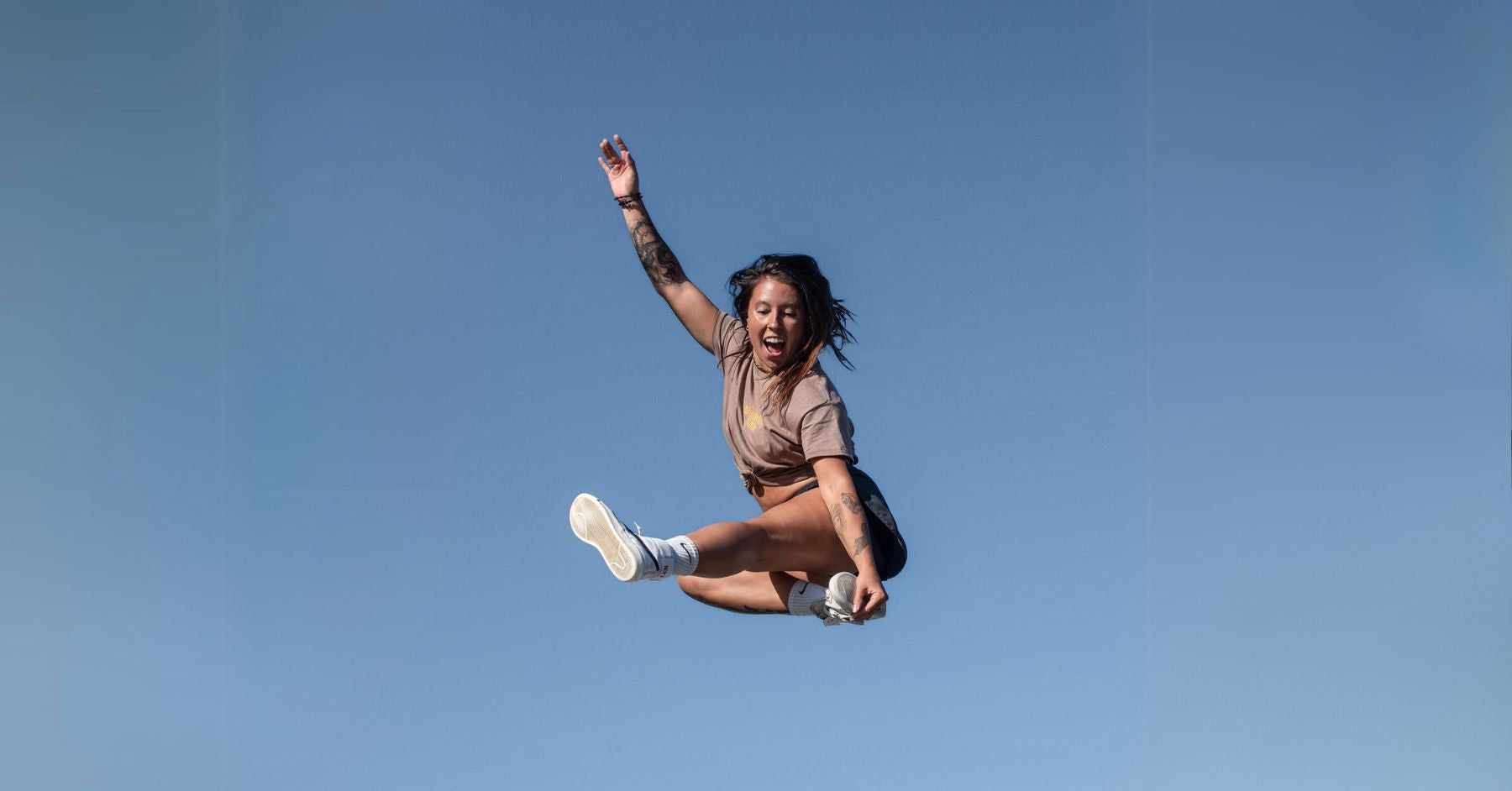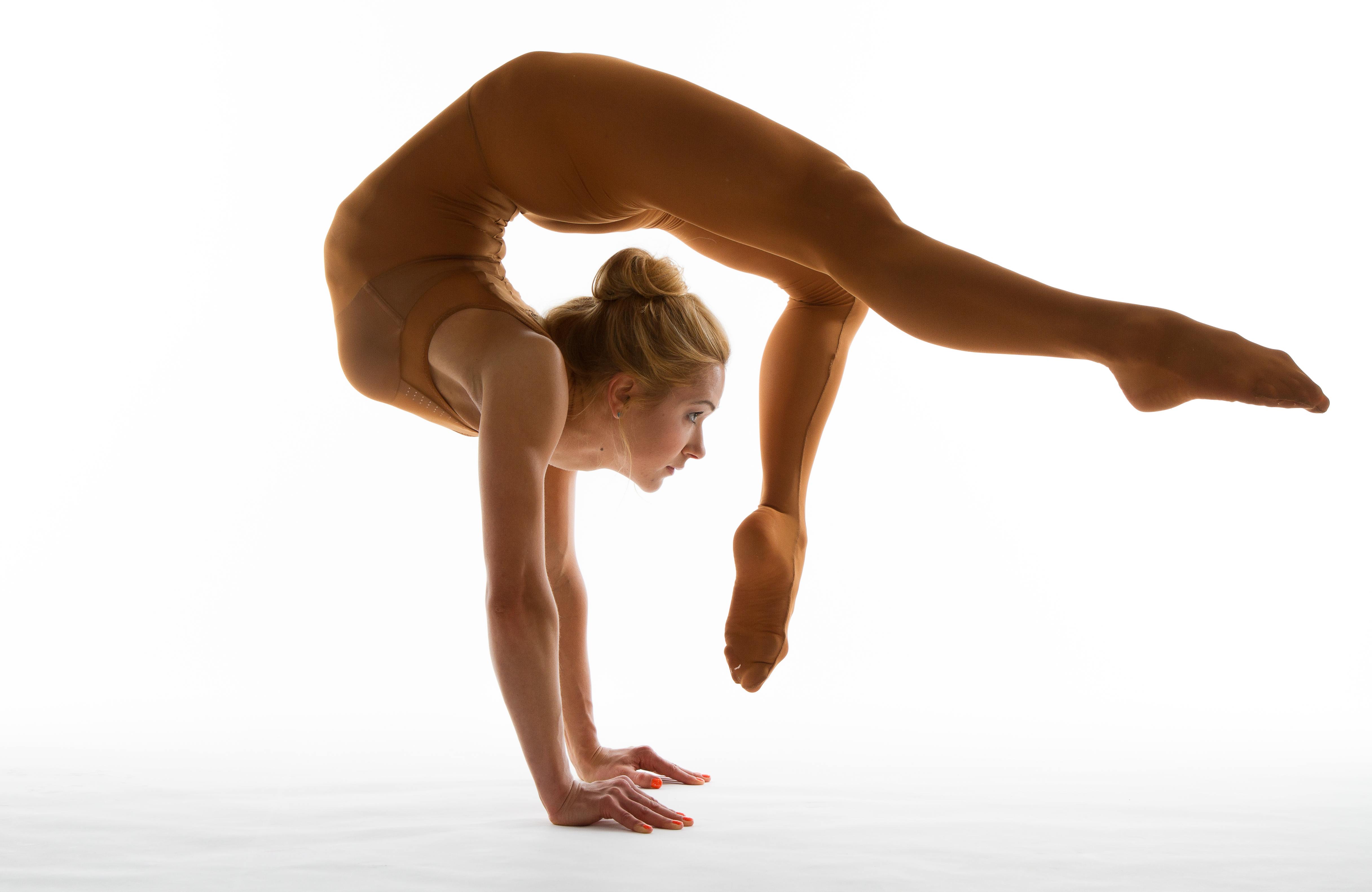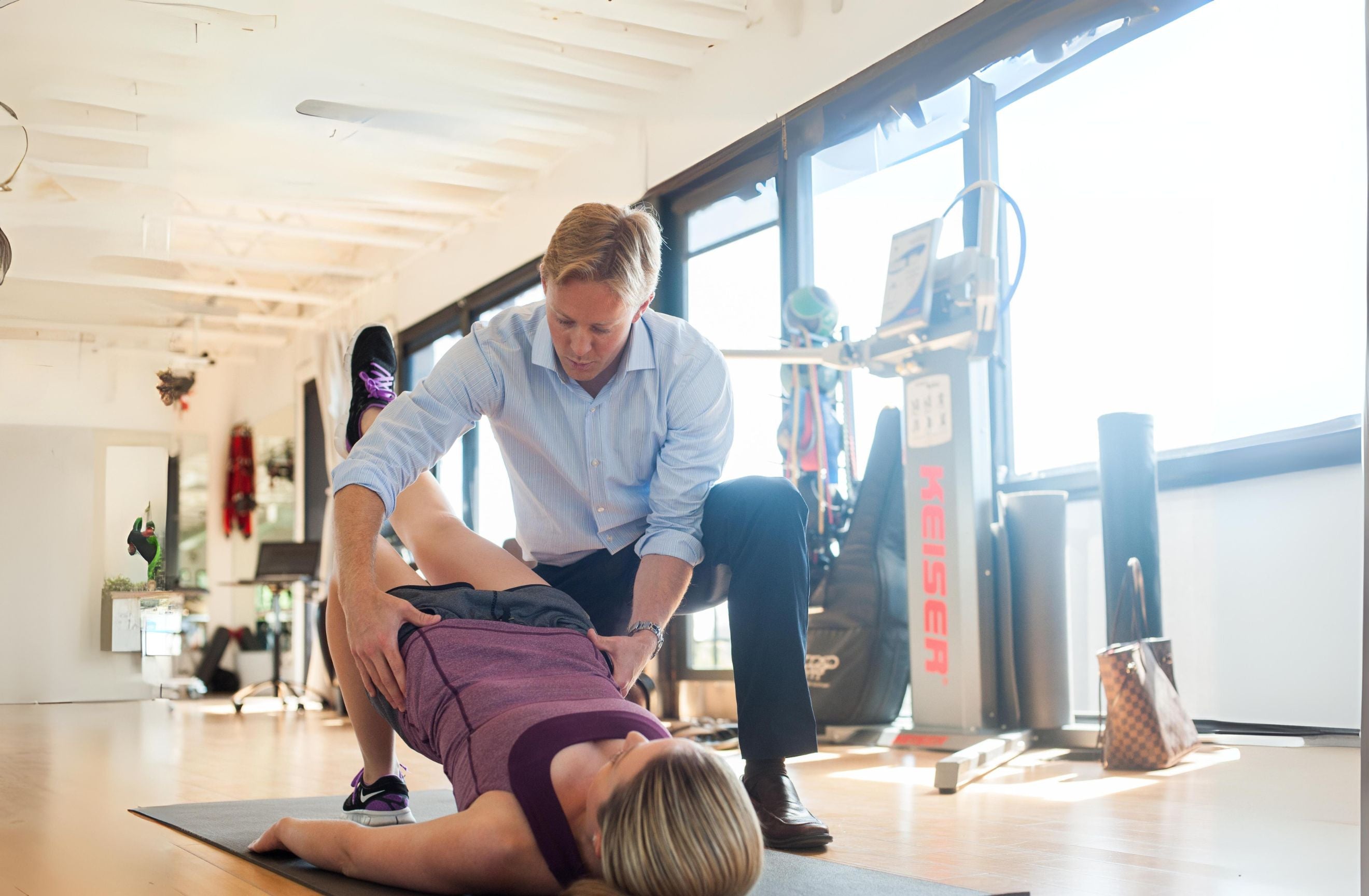
AMANDA LYNN SCHUPP
‘Embrace challenges, as they lead to the most fulfilling experiences.’

Amanda Lynn Schupp is an American Trampwall artist known for her high falls, flips, and trampoline precision. She has performed internationally, amassing a substantial online following that allows her to make a career out of training around the world. Passionate about guiding emerging artists through the professional world, Amanda believes there are countless ways to find fulfilment as an artist.
Could you define yourself and provide us with an overview of your background?
I have a dance background, then I moved into aerial, tricking, slacklining, rock climbing, and now trampwall and trampoline.
I’m definitely in pursuit of something—I think it’s about learning new things I can physically do with myself, with my muscles, and through weightlifting. So, I call myself a movement enthusiast. Sometimes I go with 'artist', and other times 'acrobat'.
What is trampwall?
It’s a bit of a mix between traditional acrobatics and an extreme sport. We’re definitely athletes and circus artists, but trampwall is like the breakdancing of dance. You don’t need to have as strict a technique, but having one helps a lot.
Basically, you bounce on a trampoline, use a wall to push yourself, and then you can project yourself upwards from the wall. Typically, you’re throwing yourself off a wall that’s about 3 to 3.5 metres high. It involves a lot of trampoline work, but we also switch the axis, which means you’re often looking up at the sky and dealing with a different set of physics.
How did you get into trampwall?
I’ve always been drawn to communities where I can learn from others. If I find people fun, I’m eager to learn from them. My interest in trampwall began when I was performing aerial and saw the fun trampoline routines of my show’s team. I started joining them at parkour gyms and met my now husband, whose friends were professional trampwall performers. They invited me to train with them, and I felt a strong connection.
Can you explain how your training day is structured?
An ideal day starts with a quick Pilates session in the morning. I follow 'Move with Nicole' on YouTube, especially enjoying the 20-minute classes. They’re perfect for stretching, deep breathing, and activating my muscles, setting me up for a successful day.
I’m really into weightlifting, which I do 3 to 4 times a week, depending on my schedule and travel. In the afternoons, we train on the outdoor trampoline from around 4 PM until sunset.

Can you share tips on how you prepare your body for training and avoid injuries?
Switching from dance to trampoline involved a lot of trial and error. I use lacrosse balls for muscle release and focus on deep breathing to help my body relax after intense sessions. Proprioception exercises from Yuka Sugiura ‘levelupneuro’ on Instagram have also been a huge help. I used to mess up a lot because I didn’t always know where I was in the air or where the ground was during a backflip. At the same time, learning the neuroscience behind high-intensity sports was huge for me because I’d train hard and then struggle with sleep because I was so wired. Muscle release, understanding my nervous system, and connecting my brain to my body are key to trampwall training.
Have you ever had a close call with ejecting completely from the trampoline?
I had my first ejection last November. Thankfully, I didn’t get a concussion, but I did hit the floor and my head pretty hard. Mentally, it took some work to overcome, especially as I was also adjusting to performing in Germany. It took a few months, but I feel stronger for having faced it.
Ejections—or falling off the trampoline frame—are rare and typically happen unexpectedly during shows. We follow strict safety rules during training, such as using spotters and mats, so most ejections are random surprises rather than routine issues.
What are the common injuries for trampwall artists?
Our number one rule is to avoid landing on our feet if we fall (on the trampoline). Instead, we try to twist and land on your back, as it’s a larger area that can handle surprise impacts better than your ankles. Falling from a height often leads to ankle injuries, and we have this rule because many early trampwall artists suffered severe ankle injuries, such as bones breaking the wrong way.
Other common issues include whiplash and muscle tension, especially in the back and neck. These can happen if you’re not properly warmed up or if you hit the trampoline wrong. Learning to decompress and release your muscles is crucial for managing these injuries.
Can more flexibility become counterproductive as a trampwall athlete?
I’ve noticed a mix, because it’s such a male-dominated sport, and you really only see it once more females start joining. For me, I build muscle faster than I gain flexibility, so I’ve had the reverse problem. I had a certain level of flexibility from dance, but now, sometimes I’ll get into a position and think, 'Why can’t I move like I used to?'
I have to put in extra work to get some of that flexibility back. Some girls, though, can hit amazing shapes, like almost a backbend during a front flip, but they have to work on getting their abs to crunch back fast. As long as you’re not prone to dislocations, working on flexibility should be good for you. It just takes time to figure out the speed and reflexes you need for trampolining.

What's your relationship with fear?
It's funny—I was actually a really timid child. I feel like a lot of what I do now is making up for the things I didn’t do as a kid. My dad used to build skate ramps in our backyard, and all the neighbourhood kids would be back there, but for some reason, I couldn’t do it. Maybe it was a social thing, like being afraid of looking foolish. So, as an adult, if I want to learn something, like skateboarding, I break it down into steps. It’s not always as simple as just wanting to do something.
A lot of fear, I think, is about getting over yourself—about the fear of looking stupid. That’s the first step, really: letting go of that. After that, it’s about figuring out how to do something safely. If I don’t feel safe, I ask, ‘What’s missing?’ Can I practise a move on the floor before trying it on a trampoline, or start from a lower ledge before a higher one? I’ve learned to take a roundabout approach so I don’t have to face the fear directly, and maybe that’s a smart way to avoid injury.
Which fear is harder to overcome: fear for your ego or fear for your physical safety?
In the beginning, it was definitely ego fear. But once I realised that how you approach it is key, it got easier. If you’re having fun and laughing at yourself, people are more likely to enjoy watching too. So I’ve learned to leave my ego out of it.
When it comes to real fear—fear for your safety—that’s changed for me over time. Early on, a lot of trampoline tricks weren’t that dangerous, so you had to face the fear head-on. Now, after four years, I’m better at recognising whether I’m just scared because it’s new or because I could actually get hurt. It’s about understanding the difference between nerves and genuine risk.
Do you ever feel like you're pushing yourself too far? Are there moments when you ask yourself, ‘What am I doing? Am I risking my future?’
No, not really. I’m a very cautious person, so I think I’ve done a good job of pacing myself. Everything I post and everything I’ve achieved has been at a rate I’m comfortable with and that I feel is sustainable. If anything, people tell me I could push a bit harder. But I’m happy with the balance—I’ve stayed safe and accomplished a lot, so I’m not too worried about what might happen.
Do you have any mental techniques or strategies to overcome hesitation when trying a new trick?
I’m a big fan of visualisation. Before I attempt any trick, I make sure I’ve done the prep work, used mats, and followed my coach's advice. When it’s time to do the trick, I visualise it a few times and really put myself in that moment, seeing it clearly.
In more extreme cases of fear, I’ve actually pretended to be someone else—someone who’s really good at the trick. I’ll visualise them doing it and, for that moment, act like I’m them. It has worked really well for me.
What advice would you give to those who are afraid of trying new things?
My rule is that whatever you want to try, commit to doing it 3 to 5 times before forming an opinion. For example, if you're taking an adult gymnastics class, pay upfront for five classes, and don’t judge it until you've done all five.
Day 1 will feel overwhelming because everything’s new. But by the second class, you’ll likely see a 20-30% improvement—you'll know the warm-up, the coach, the people. By the fifth class, there are way fewer unknowns. So, if you commit to that upfront work, it makes things a lot smoother. I use this approach myself to manage any potential ego bruises.
You mentioned that art is rebellion. What do you mean by that, especially as an artist?
It’s funny because I grew up being told art is rebellion, but I didn’t quite get it at first. I had so much support—teachers, my mum, scholarships—everything was set up for me to succeed as an artist. But when I started working professionally, I suddenly had to deal with things like making money, balancing friendships, managing a home, and it was easy to get caught up in the pressure of all that.
For me, art became a rebellion when I learned to separate myself from those expectations. It’s about creating for myself and doing things that fulfil me, even if, a lot of times, it can imply that the artistic result might not have a monetary value. That’s where the rebellion comes in—choosing to do something meaningful for me, not just what the world expects.
And now I can travel because of it, and I get to create more. It was just that rebellious act of separating from what the world seems to want. Funny enough, TikTok ended up being the place where I started sharing my art, which I never expected, but it has opened up so many opportunities.

How do you mentor the younger artists’ generation?
When the pandemic hit, many of us were thriving on social media, but with gyms closing, we decided to move into an Airbnb together. We found one that allowed us to set up trampolines, and that collaboration really enhanced our training and connections. We trained together, shared resources, and that synergy continued even after gyms reopened. Now, we have a seven-bedroom house in Southern California where acrobats can stay, whether they’re between contracts or just need a place to train. We train together, work on videos, and assist and assist up-and-coming performers with resumes, job preparation, and even the basics of getting started in this field. It’s a dynamic environment, and part of the adventure is not knowing exactly who will be around next.
Do you see many new talents coming in that you teach from scratch?
Yes, thanks to social media and TikTok, we're aware of emerging talents and we also host trampoline camps. Some young talents, who start around 16 or 17, return at 18 and stay with us for extended periods, sometimes becoming long-term roommates and building full careers in the sport. We also see remarkable progress from new faces—like a girl with action sports experience who has impressed us greatly over the past two years. This is particularly inspiring given the underrepresentation of women in trampwall.
How would you describe the dynamic among your peers?
With so few women in trampwall, I started the Trampwall Women group chat with about 25 members worldwide. It’s a supportive space where we share tricks and advice. It is competitive in the sense that most shows feature only one girl. However, with so few of us scattered around the world, it’s not really an issue.
How long did it take for your videos to get views?
It took me about a year of consistent posting before my first viral video. Initially, views and recognition were slow, but dedicating time to creating content paid off. My breakthrough came with a video that reached 500,000 views, followed by one with 100 million views. Consistency is key—I posted daily during the pandemic and now I aim for three to five times a week. Obviously, if you make good videos, you can pull off posting three times a week. Building a library of content helps sustain growth.
What is an adventurous lifestyle for you? What does that imply?
An adventurous lifestyle means approaching challenges with a mindset of making things happen rather than giving up. Instead of thinking something won't work, I focus on figuring out the steps needed to achieve it. For example, when I missed my flight to hike Mount Fuji in Japan, I didn’t let it stop me. I navigated my way from Osaka to Tokyo using bullet trains and metro, and still managed to hike Mount Fuji the next day. It’s about adapting and finding a way to turn obstacles into opportunities for adventure.

Where do you see yourself in five or twenty years?
In twenty years, I see us continuing with communal living, possibly owning land where people can stay and train, with a separate house for us. We love Europe, especially Spain, and are exploring how to make that happen.
We have many ideas and are seeing which ones stick, staying positive even if some don't work out. I would also love to have kids one day and am figuring out what that would look like and how we would balance it with our trampwall careers.
Is there a final message you’d like to share with our readers?
Well, given what I do, people can often assume I’m an adrenaline junkie, but I’m actually not at all. What truly drives me is the process of improving myself is seeing progress, especially when I start out being really bad at something. My biggest challenge has been learning to handle adrenaline, and I encourage others to manage stress and adrenaline healthily. Life offers so many opportunities for growth, whether it's through public speaking, singing, cooking, or any hobby. Embrace these challenges, as they lead to the most fulfilling experiences. Thank you for allowing me this space, and I hope my journey can inspire others to push their boundaries and find joy in their growth.
Find Amanda on Instagram | Tik Tok | Youtube














Leave a comment
This site is protected by hCaptcha and the hCaptcha Privacy Policy and Terms of Service apply.